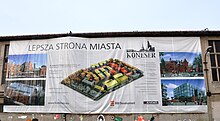Warszawska Wytwórnia Wódek "Koneser"
The Warszawska Wytwórnia Wódek "Koneser" ( vodka factory "Koneser" ) in Warsaw was located in the Praga-Północ district east of the Vistula at ul. Ząbkowska. The neo-Gothic factory was built at the end of the 19th century and housed one of the largest vodka producers in Poland. Today, parts of the listed complex are integrated into a completely redesigned residential, shopping and office complex, the Centrum Praskie Koneser .
history
In 1867 the construction of a vodka factory began, which replaced a hut bazaar that had existed on this site since the end of the 18th century. The last construction work was completed in 1897. At the turn of the century, the surrounding town of Szmulowizna became a part of Warsaw. The factory Rektyfikacja Warszawska na Pradze (in German: Warsaw rectification in Praga ) belonged to the Polish-Russian Warszawskiego Towarzystwa Oczyszczania i Sprzedaży Spirytusu (in German: Warsaw Society for Cleaning and Selling Spirits ), which already ran a distillery in Powiśle between the Rektyfikacja Warszawska and the Tsarist Russian state treasury.
The facility, which stretched over around 50,000 square meters between Ząbkowska, Markowska, Białostocka and Nieporęcka streets, was one of the largest distilleries in the Russian Empire at the time . Its founders had pledged to the approving authorities to produce a million buckets of brandy a year. The factory reached its largest output between the wars. Around 400 people worked in the plant, which was renamed Państwowy Monopoly Spirytusowy - Rektyfikacja Spirytusu i Wytwórnia Wódek after the First World War . In addition to the internationally known brands " Wyborowa " (since 1927) and " Luksusowa " (since 1928), vodkas of the brands " Żubrówka ", "Żytniówka", "Wystawowa", "Przepalanka", "Chlebowa", "Świtezianka", "Redlówka" were made "," Siwucha "and" Starka "are produced.
One of the first Warsaw drinking water wells was drilled in the factory, reaching water from the Oligocene at a depth of 260 meters . After the retreating Russian troops had blown up the Kierbedzia Bridge including the water supply pipes for Praga running there in 1915 , not only vodka production but also surrounding residential areas were supplied from the spring. The spring can still be used today for private drinking water supply.
In 1918, a coin and medal production facility was set up in one of the buildings (on Markowska Street). In the 1930s, the vaults of the Obrony Narodowej Fund (in German: National Defense Fund ) were located in the factory's basement . From 1938 the factory operated as Polski Przemysł Wódczany Sp. Akc. Rektyfikacja Warszawska (in German: Polish Vodka Industry SA, Warsaw rectification ). During the German occupation , the plant operated as the Warsaw Drinking Alcohol and Alcohol Cleaning Plant . It has belonged to the Polmos group since 1947 .
After the turn
After the plant became increasingly unprofitable in the 2000s, vacant spaces began to be used for cultural events. Galleries and theaters settled here. In 2009 the alcohol production was stopped. The “Wytwórnia” theater (which also presented exhibitions and video art) as well as the “Luksfera” (artistic photography), “Galeria Klimy Bocheńskiej” (modern art) and “Magazyn Praga” (designer concept) galleries moved into the former factory premises Store). An extensive second-hand bookshop was also located, in which fairs for second-hand books were held.
Until the completion of the new museum headquarters on Ulica Targowa , the offices and exhibition space of the Warsaw-Praga Museum will also be located in the factory premises. In two halls there were exhibits of the Motor and Technology Museum Otrębusy . Cars and trucks as well as entertainment electronics were exhibited here. The factory facilities were often used for parties and music festivals.
Refurbishment and new use
As part of a partial renovation and conversion of the entire facility, a joint project concept was developed by the real estate companies BBI Development and Juvenes Projekt in the 2010s . The plans provided for the maintenance and expansion of the existing building fabric in addition to the construction of additional residential and office buildings and were implemented by 2018. The Museum of Polish Vodka was built in the former rectification building .
"Koneser" today
The future of the company "Koneser" is unclear. The over-indebted and insolvent company now produces elsewhere, employs around 100 people and operates a chain of 20 spirits sales outlets in the Masovian Voivodeship .
architecture
The factory is an example of Central European industrial architecture at the end of the 19th century. The buildings are made of red brick with echoes of Gothic / medieval design structures. The entrance is flanked by a castle-like building.
Individual evidence
- ↑ according to Information Warszawa Wytwórnia Wódek "Koneser" at Polskaniezwykla.pl (in Polish)
- ↑ according to Information Koneser Vodka Distillery ( Memento of the original dated November 30, 2010 in the Internet Archive ) Info: The archive link was inserted automatically and has not yet been checked. Please check the original and archive link according to the instructions and then remove this notice. at Warsawtour.pl (in English)
- ↑ according to a note on the Warsaw Free Form Festival 2011 at Lastfm.pl (in Polish)
- ↑ according to Article Zabytkowa fabryka wódek Koneser na sprzedaż ( memento from October 26, 2010 in the Internet Archive ) at Wiadomosci.gazeta.pl from August 24, 2006
- ↑ according to a listing Koneser - Opis sieci at E-sieci.pl
Web links
- Website of the "Teatr Wytwornia"
- Warszawska Wytwórnia Wódki Koneser. In: koneservodka.pl. April 1, 2019, accessed April 1, 2019 (Polish).
Coordinates: 52 ° 15 '19.2 " N , 21 ° 2' 39.3" E






